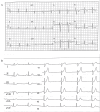How to Approach Patients with Acute Chest Pain
- PMID: 39228492
- PMCID: PMC11366986
- DOI: 10.31083/j.rcm2508302
How to Approach Patients with Acute Chest Pain
Abstract
Acute coronary syndrome (ACS) is associated with high mortality rates. Although the goal was to achieve a missed diagnosis rate of 1%, the actual data showed a rate of 2%. Chest pain diagnosis has remained unchanged over the years and is based on medical interviews and electrocardiograms (ECG), with biomarkers playing complementary roles. We aimed to summarize the key points of medical interviews, ECG clinics, use of biomarkers, and clinical scores, identify problems, and provide directions for future research. Medical interviews should focus on the character and location of chest pain (is it accompanied by radiating pain?) and the duration, induction, and ameliorating factors. An ECG should be recorded within 10 minutes of the presentation. The serial performance of an ECG is recommended for emergency department (ED) evaluation of suspected ACS. Characteristic ECG traces, such as Wellens syndrome and De Winter T-waves, should be understood. Therefore, troponin levels in all patients with suspected ischemic heart disease should be examined using a highly sensitive assay system. Depending on the ED facility, the patient should be risk stratified by serial measurements of cardiac troponin levels (re-testing at one hour would be preferred) to determine the appropriate time to perform an invasive strategy for a definitive diagnosis. The diagnostics should be based on Bayes' theorem; however, care should be taken to avoid the influence of heuristic bias.
Keywords: 0-hour/1-hour algorithm; chest pain; emergency department; high sensitive cardiac troponin.
Copyright: © 2024 The Author(s). Published by IMR Press.
Conflict of interest statement
Dr. Inoue received a research grant from Grant-in-Aid for Scientific Research C (No. 18K09954), Roche Diagnostics, SB Bioscience Co., Ltd., Fujirebio Inc., Bayel Sysmex, and Kanto Chemical Co. Inc. Dr. Minamino received a research grant from Roche Diagnostics. Kenji Inoue is serving as Guest Editor of this journal. We declare that Kenji Inoue had no involvement in the peer review of this article and has no access to information regarding its peer review. Full responsibility for the editorial process for this article was delegated to Stefano De Servi. Otherwise, there are no conflicts of interest to declare.
Figures


Similar articles
-
Assessing sensitivity and specificity of the Manchester Triage System in the evaluation of acute coronary syndrome in adult patients in emergency care: a systematic review protocol.JBI Database System Rev Implement Rep. 2015 Nov;13(11):64-73. doi: 10.11124/jbisrir-2015-2213. JBI Database System Rev Implement Rep. 2015. PMID: 26657465
-
Pre-hospital evaluation of chest pain patients using the modified HEART-score: rationale and design.Future Cardiol. 2024 Apr 25;20(5-6):241-250. doi: 10.1080/14796678.2024.2356995. Epub 2024 Jun 28. Future Cardiol. 2024. PMID: 38940186
-
The Erlanger chest pain evaluation protocol: a one-year experience with serial 12-lead ECG monitoring, two-hour delta serum marker measurements, and selective nuclear stress testing to identify and exclude acute coronary syndromes.Ann Emerg Med. 2002 Dec;40(6):584-94. doi: 10.1067/mem.2002.129506. Ann Emerg Med. 2002. PMID: 12447334
-
Systematic review and modelling of the investigation of acute and chronic chest pain presenting in primary care.Health Technol Assess. 2004 Feb;8(2):iii, 1-158. doi: 10.3310/hta8020. Health Technol Assess. 2004. PMID: 14754562 Review.
-
[Is a more efficient operative strategy feasible for the emergency management of the patient with acute chest pain?].Ital Heart J Suppl. 2000 Feb;1(2):186-201. Ital Heart J Suppl. 2000. PMID: 10731376 Review. Italian.
References
-
- Lee TH, Goldman L. Evaluation of the patient with acute chest pain. The New England Journal of Medicine . 2000;342:1187–1195. - PubMed
-
- Pines JM, Pollack CV, Jr, Diercks DB, Chang AM, Shofer FS, Hollander JE. The association between emergency department crowding and adverse cardiovascular outcomes in patients with chest pain. Academic Emergency Medicine: Official Journal of the Society for Academic Emergency Medicine . 2009;16:617–625. - PubMed
-
- Storrow AB, Gibler WB. Chest pain centers: diagnosis of acute coronary syndromes. Annals of Emergency Medicine . 2000;35:449–461. - PubMed
Publication types
LinkOut - more resources
Full Text Sources


